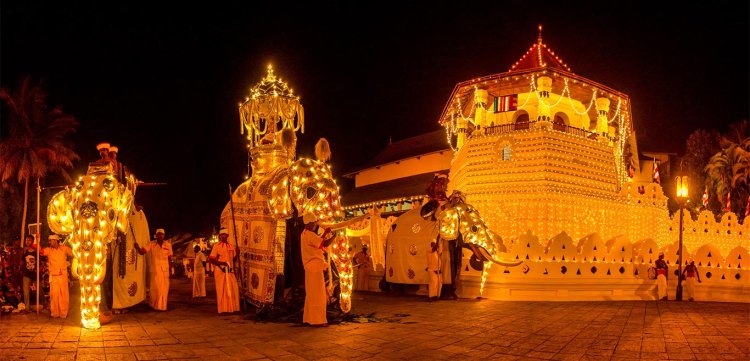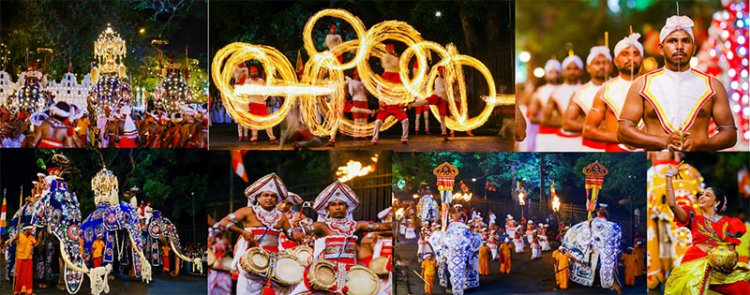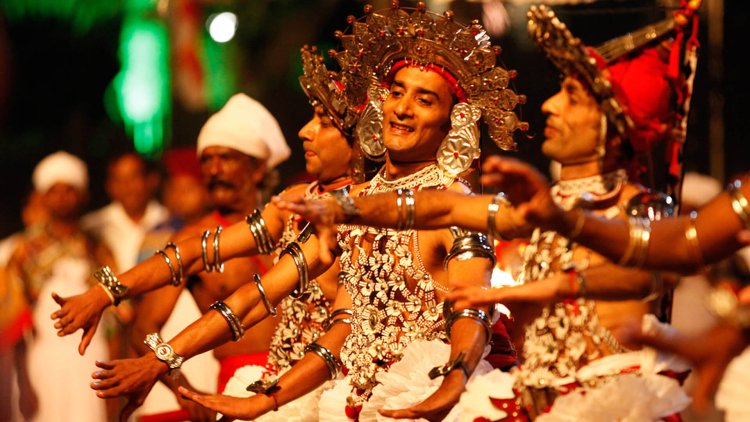Kandy Esala Perahera: Sri Lanka’s Most Vibrant Cultural Festival
Experience the Kandy Esala Perahera, Sri Lanka’s vibrant cultural festival! Witness dazzling processions, Kandyan dance, and sacred rituals. Plan your visit with our guide at imsrilanka.com.

Introduction to Kandy Esala Perahera: A Cultural Spectacle
Imagine the streets of Kandy, Sri Lanka’s cultural heart, alive with the rhythmic beat of drums, the glow of torches, and the majestic parade of adorned elephants. The Kandy Esala Perahera, held annually in July or August, is one of the world’s most spectacular festivals, a 10-day celebration honoring the Sacred Tooth Relic of Lord Buddha. This UNESCO-recognized event, rooted in centuries of tradition, transforms the hill city into a vibrant tapestry of dance, music, and devotion, drawing travelers from across the globe to witness its magic.
As a cornerstone of Sri Lanka’s cultural heritage, the Kandy Esala Perahera offers an immersive experience under the Things to Do category, specifically within Cultural Experiences. For international visitors, it’s a chance to dive into the soul of Sri Lanka, where spirituality and artistry intertwine against the backdrop of Kandy’s misty hills. This guide explores why the Perahera is a must-see, what makes it an unforgettable cultural event, and how to plan your visit for a front-row seat to this dazzling spectacle. From the mesmerizing Kandyan dancers to the sacred procession, here’s everything you need to know about experiencing the Kandy Esala Perahera.

Why Experience the Kandy Esala Perahera?
The Kandy Esala Perahera stands out as a cultural experience that captures the essence of Sri Lanka’s traditions and community spirit. Held in Kandy, the last royal capital of the Sinhala kingdom, this festival is both a religious pilgrimage and a vibrant celebration, making it a bucket-list event for travelers. Here’s why it’s a must-do for foreign visitors:
-
Cultural Richness: The Perahera showcases Sri Lanka’s Kandyan dance, traditional music, and Buddhist devotion, offering a deep dive into local heritage.
-
Spectacular Processions: Over 10 nights, parades feature elaborately decorated elephants, fire dancers, and drummers, creating a sensory feast.
-
Spiritual Significance: Honoring the Sacred Tooth Relic, housed in the Temple of the Tooth, the festival connects visitors to Sri Lanka’s Buddhist roots.
-
Community Vibrance: Locals and pilgrims unite, creating a warm, inclusive atmosphere that welcomes international guests.
-
Unique Timing: Held during the Esala full moon, the festival’s timing adds a mystical ambiance, perfect for cultural explorers.
For travelers seeking authentic experiences, the Kandy Esala Perahera offers a rare chance to witness Sri Lanka’s living traditions in an unforgettable setting, making it a highlight of any cultural itinerary.

The History and Significance of the Perahera
The Kandy Esala Perahera traces its origins to the 3rd century AD, when the Sacred Tooth Relic, believed to be a tooth of Lord Buddha, was brought to Sri Lanka. The festival began as a ritual to honor the relic, housed in Kandy’s Temple of the Tooth (Sri Dalada Maligawa), and evolved into a grand procession under the Kandyan kings in the 18th century. Combining Buddhist reverence with ancient Sinhala traditions, the Perahera also invokes blessings for rain and prosperity, reflecting its agrarian roots.
The festival spans 10 nights, culminating in the grand Randoli Perahera, followed by a daytime procession. Each night, the procession grows in splendor, featuring the Maligawa Tusker, an elephant carrying a replica of the relic’s golden casket, accompanied by dancers, drummers, and flag bearers. The event is organized by the Temple of the Tooth and four devales (shrines) dedicated to deities like Natha and Vishnu, showcasing Sri Lanka’s multi-faith harmony.
For international visitors, the Perahera is a window into Sri Lanka’s spiritual and historical depth, blending devotion with a celebration of artistry that has captivated audiences for centuries.
Experiencing the Kandy Esala Perahera: Top Highlights
The Kandy Esala Perahera is a sensory extravaganza, with each element contributing to its magic. Here are the key experiences that make it unforgettable:
1. Watching the Grand Procession
As dusk falls, Kandy’s streets come alive with the Perahera’s procession. The air hums with the beat of traditional drums—hewisi and dawula—while torchbearers light the way with crackling flames. Elephants, draped in glittering costumes, march in sync, led by the majestic Maligawa Tusker carrying the relic’s replica. Kandyan dancers, adorned in silver headdresses and intricate costumes, perform mesmerizing spins, their movements telling stories of ancient legends. Fire dancers twirl blazing batons, casting sparks into the night sky, while flag bearers wave colorful banners.
The procession, stretching over a kilometer, winds through Kandy’s historic streets, with crowds lining the route. The energy is electric, a blend of reverence and celebration that pulls you into the moment. Each night builds in grandeur, with the final Randoli Perahera featuring the most elaborate displays.
Travel Tip: Arrive early (4-5 PM) to secure a good viewing spot, or book a reserved seat for $20-50 USD through imsrilanka.com for comfort.
2. Exploring Kandyan Dance and Music
The Perahera is a showcase of Kandyan dance, a classical art form unique to Sri Lanka’s hill country. Dancers perform intricate steps, accompanied by rhythmic drumming that echoes through the streets. The ves dance, with its iconic silver headdress, is a highlight, symbolizing grace and strength. Drummers, in vibrant costumes, create a pulsating beat that sets the procession’s tempo, inviting you to sway along.
Travel Tip: Visit a cultural show at the Kandy Cultural Centre ($5-10 USD) before the Perahera to learn about Kandyan dance and its significance.
3. Visiting the Temple of the Tooth
The Perahera revolves around the Temple of the Tooth, a sacred site housing the Sacred Tooth Relic. Before or after the procession, visit the temple to witness puja ceremonies, where monks offer flowers and chant prayers. The temple’s golden-roofed architecture and serene ambiance provide a spiritual prelude to the festival’s energy.
Travel Tip: Attend the evening puja (6:30 PM) for a quieter experience, and dress modestly (covering shoulders and knees). Entry is $10 USD for foreigners.
4. Joining the Festive Atmosphere
Kandy during the Perahera is a city transformed, with streets adorned with lanterns and vendors selling lotus flowers, incense, and street food like kottu roti. Families in white attire, pilgrims, and tourists mingle, creating a warm, communal vibe. The scent of jasmine and the glow of oil lamps add to the festive magic, making every corner of Kandy feel alive.
Travel Tip: Try street food like isso vade (spicy prawn fritters) for $1-2 USD, and engage with locals to learn about their Perahera traditions.
5. Witnessing the Day Perahera
The festival concludes with the Day Perahera, a smaller procession held the morning after the final Randoli. While less crowded, it offers a brighter view of the costumes and performances, perfect for photography and a relaxed experience.
Travel Tip: Head to the Temple of the Tooth grounds for the Day Perahera, which starts around 8 AM, and bring a camera for vibrant shots.

Planning Your Perahera Visit: Practical Tips for Foreign Travelers
To make your Kandy Esala Perahera experience seamless and memorable, here are essential tips for international visitors:
Getting to Kandy
Kandy is 115 km from Colombo, easily accessible:
-
By Train: The scenic Colombo-Kandy train (2.5-3 hours, $2-10 USD) offers stunning hill views. Book first-class seats for comfort.
-
By Bus: Buses from Colombo to Kandy take 3-4 hours ($2-5 USD) and run frequently.
-
By Private Car: A car with a driver costs $50-80 USD, ideal for flexibility.
-
By Tuk-Tuk: From nearby towns like Peradeniya, a tuk-tuk costs $5-10 USD.
Travel Tip: Book train tickets in advance via imsrilanka.com, especially during the Perahera (July-August), as seats sell out fast.
Best Time to Visit
The Kandy Esala Perahera is held in July or August, based on the Esala full moon (check exact dates for 2025 on imsrilanka.com). The weather is warm (20-25°C) with occasional rain, adding a mystical vibe. The final three nights (Randoli Perahera) are the most spectacular but crowded.
Travel Tip: Plan to attend mid-week processions for fewer crowds, and pack a lightweight raincoat for showers.
What to Bring
-
Lightweight, modest clothing (covering shoulders and knees) for temple visits
-
Comfortable shoes for walking Kandy’s streets
-
A scarf or sarong for extra coverage
-
A reusable water bottle and sunscreen for daytime activities
-
A camera or smartphone for capturing the procession
Travel Tip: Pack an umbrella for rain, and use a secure bag to protect valuables in crowded areas.
Where to Stay
Kandy offers a range of accommodations, but book early due to Perahera crowds:
-
Budget: Clock Inn Kandy ($15-25 USD/night) for central, affordable stays.
-
Mid-Range: Theva Residency ($50-80 USD/night) for boutique comfort with hill views.
-
Luxury: Earl’s Regency ($100-150 USD/night) for 5-star amenities near the city.
Travel Tip: Stay near Kandy Lake or the city center for easy access to the procession route, and book via imsrilanka.com for deals.
Cultural Experiences: Immersing in Kandy’s Traditions
Deepen your Perahera experience with these cultural activities:
-
Local Cuisine: Savor rice and curry, hoppers, or string hoppers at Balaji Dosai, where spicy flavors burst with authenticity.
-
Market Stalls: Shop for batik clothing, spices, or gems at Kandy’s Central Market, vibrant during the festival.
-
Temple Rituals: Join locals in offering flowers or lighting oil lamps at the Temple of the Tooth for a spiritual connection.
What's Your Reaction?

















